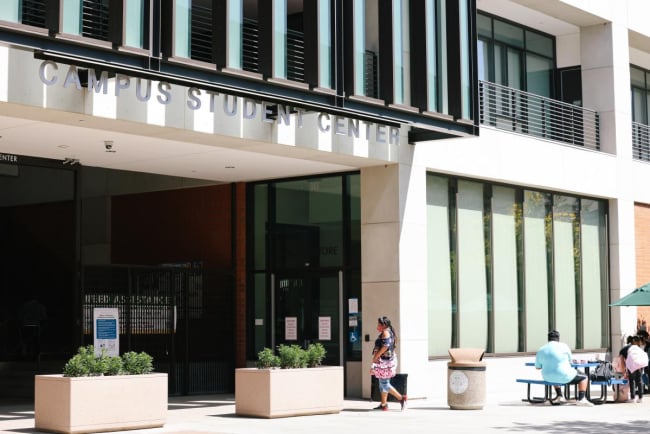You have /5 articles left.
Sign up for a free account or log in.

Enrollment is down for the fifth semester in a row, despite early signs that a post-pandemic rebound was possible this fall.
Dania Maxwell/Los Angeles Times via Getty Images
As the effects of the pandemic wane, higher education leaders and researchers have been anxiously awaiting this fall’s enrollment numbers to reveal a clearer picture of the new landscape. While early signs led many to predict a slight rebound from the steep two-year drop-off during the pandemic, a new report from the National Student Clearinghouse Research Center shows that enrollment fell for the fifth semester in a row, dampening those hopes.
Overall enrollment fell by 1.1 percent, closer to pre-pandemic levels than the more drastic declines that shocked leaders over the past two years. The rate of decline has decreased by almost a third since fall 2020.
But Doug Shapiro, the research center’s executive director, said that while a slower descent is welcome, this semester’s numbers are no cause for celebration.
“I certainly wouldn’t call this a recovery,” he said. “We’re seeing smaller declines, but when you’re in a deep hole, the fact that you’re only digging a tiny bit deeper isn’t exactly good news.”
Since 2019, Shapiro said, the NSC’s numbers show a combined decline of almost 7.5 percent across all higher education sectors.
Data from this spring’s FAFSA, which saw a 4.6 percent increase in applications over last spring, gave higher education leaders some hope that a post-pandemic rebound was imminent this fall, especially among minority and low-income students. Shapiro said those expectations have been roundly subverted.
“Our biggest concern is that we aren’t seeing a huge upsurge back in freshman enrollment at four-year institutions. So those two lost years of high school graduates who didn’t enroll in fall 2020 or fall 2021, there’s not a lot of evidence of them coming back,” Shapiro said. “Many institutions are still below their freshman numbers from last year, let alone 2019, and that’s very concerning.”
“The fact that we’re not regaining a great deal of ground this fall is a surprise to many,” he added.
Community Colleges Stop the Free Fall
One bright spot came in the sector hit hardest by the pandemic: community colleges. While overall enrollment at two-year institutions is still down, it only shrank by 0.4 percent since fall 2021, a significant improvement over the nearly 10 percent decline community colleges suffered in both 2019 and 2020. And for the first time since 2019, enrollment declines were worse at public four-year institutions than community colleges.
John Fink, a senior research associate at the Community College Research Center of Teachers College at Columbia University, said the data are a welcome sign that the tide may be starting to turn, however slowly, for the beleaguered institutions.
“It looks like we might be finally coming out of this troubling pandemic free fall,” he said. “It’s a bit of a vote of confidence from new students, which is encouraging.”
One factor driving the shift was an 11 percent increase in dual enrollment of high school students—growth that helped offset continuing declines in enrollment among adult learners.
Fink said dual enrollment had been growing steadily before the pandemic; in fall 2019, it accounted for 16 percent of overall community college enrollment. The growth started to stabilize in 2020, but Fink anticipates it will resume as the pandemic fades.
“Because there’s been a massive decline in older adult enrollment, the growth of dual enrollment seems to be almost propping up new student growth for community colleges,” he said. “I think what this shows is that dual enrollment is going to be a really important constituency for community colleges to think about as part of their institutional strategy.”
But Fink also cautioned against undue optimism for community colleges, considering that their declines were much more severe than any other higher education sector over the previous two years.
“Community colleges are still in a pretty big hole from the pandemic,” he said. “Even if this is a slight increase in new students, some slight progress making our way out of that hole, there’s still a lot more ground to cover and a lot of rebuilding to be done.”
Trends Both Old and New
Many patterns seen throughout the pandemic carried over to this semester. The most selective four-year institutions saw continued enrollment increases. Demographic patterns, as usual, varied by state and region, with the Midwest and Northeast experiencing the biggest enrollment declines. Computer science majors were up by 10 percent in both bachelor’s and master’s programs, while health sciences majors fell by 5 percent across the board.
Some new trends emerged as well. More traditional-age college students were enrolled in online programs this fall, a trend that Shapiro said seems like “a natural outcome” of the normalization of online learning during the pandemic. And graduate enrollment is down for the first time since the pandemic prompted a boom in applications, a phenomenon that Mikyung Ryu, the NSC’s director of research publications, attributes to shifting economic priorities.
“My theory would be that the initial shock of the pandemic in fall 2020 for newly minted graduates made them want to buy a little time by enrolling in grad school,” she said. “As the labor market is turning the other direction, maybe they are more interested in employment.”
Enrollment declines were steeper among women than men for the second year in a row, reversing a longtime trend.
“We are seeing female students continue to struggle more, and that is across the board at every level of education,” Ryu said. “I think this is indicative of some unique challenges facing women students as the pandemic is lingering longer … [whether] that’s urgent family needs or a lack of educational support for working women.”
Enrollment declines for white students were steeper than any other group this fall—a shift from previous pandemic trends, which saw minority groups fall away more than others. Still, there was no growth for any ethnic group except for Latino students. Black student enrollment was down by 1.6 percent, the largest drop after white students. Enrollment at HBCUs, however, increased by 1.9 percent this fall after dropping by 1.3 percent in 2021.
Kathy Dawley, who works on recruitment and enrollment initiatives at EAB, an education consulting firm, said the lesson this semester is that institutions can’t rely on a “natural rebound” from the pandemic. Between the shift to online learning, worsening economic hardships and heightened skepticism about the value of higher education, Dawley said colleges and universities will have to adapt to a new normal for prospective applicants.
“It’s so clear that we have to do something different,” she said. “Things have permanently changed.”






